How the Chainlink Platform Unlocks LST and LRT Adoption in DeFi
Liquid staking has become one of the largest sectors in DeFi, with over $44B in TVL. Restaking, and by extension liquid restaking, have also grown at an exponential rate, with restaking representing approximately $14.6B in TVL (of which $9.5B is in liquid restaking form). While these represent large markets, if they are to remain secure and continue to grow, they require a variety of data, compute, and cross-chain services to increase their composability and trustworthiness within DeFi.
The following post is an overview of liquid staking/restaking, their associated assets (LSTs/LRTs), and how the Chainlink platform for data, compute, and cross-chain services is a must-have requirement for both LST/LRT asset issuers and the DeFi protocols that support them.
Liquid Staking, LSTs, and LSTfi Explained
In the blockchain ecosystem, staking is when a protocol—blockchain, dApp, or oracle—enables participants to lock up their tokens in order to help secure that protocol. In exchange, stakers receive staking rewards. Staking is generally a form of cryptoeconomic security, where the staked assets act as an incentive mechanism for guaranteeing certain properties of the protocol, such as censorship resistance, Sybil resistance, or high availability.
Liquid staking was introduced in an attempt to bring more capital efficiency to staked tokens. Liquid staking is when stakers receive transferable liquid staking tokens (LSTs) after depositing their stake into a protocol. The LSTs represent ownership of the underlying staked assets and can then be used as collateral in DeFi applications or other Web3 protocols while simultaneously accruing rewards from the underlying staked assets. The use of LSTs in DeFi is sometimes referred to as LSTfi.
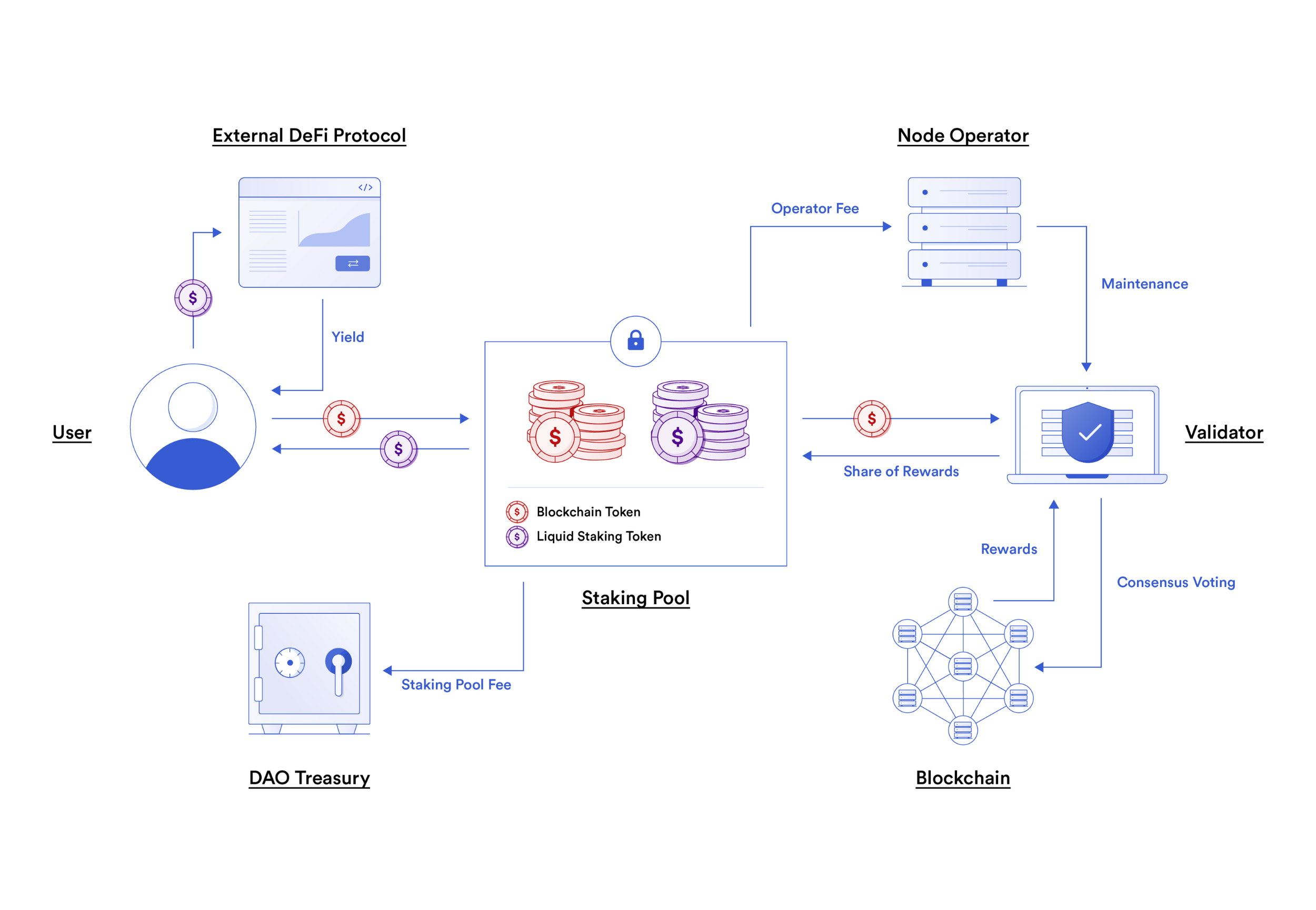
Restaking, LRTs, and LRTfi Explained
Restaking expanded on the concept of staking by enabling staked assets and LSTs to be “restaked” to help provide cryptoeconomic security or other services to third-party protocols in return for additional rewards. Users can also use specialized protocols to receive liquid restaking tokens (LRTs), which represent ownership of the underlying restaked assets. The use of LRTs in DeFi is sometimes referred to as LRTfi.
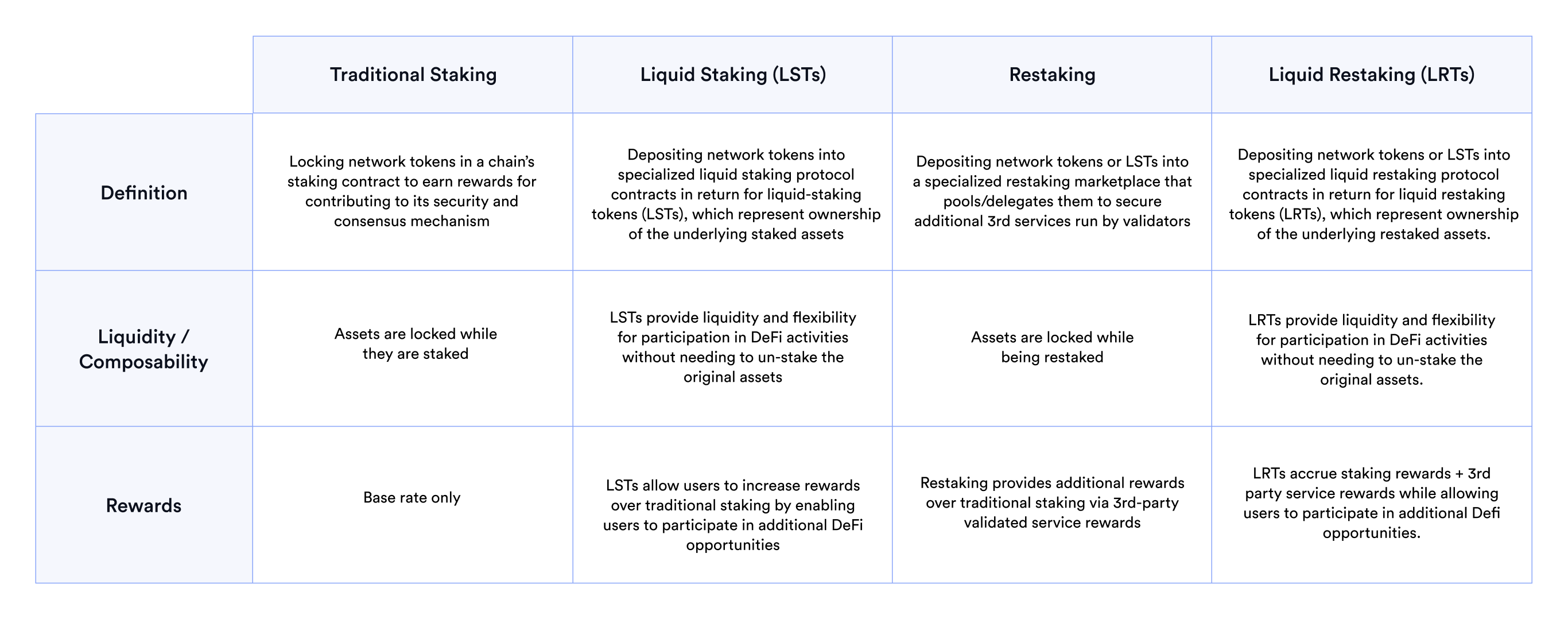
The Two Types of LSTs and LRTs
There are two main token designs for LSTs and LRTs:
- Rebasing LST/LRT tokens are when the token’s supply changes algorithmically to reflect an increase or decrease in the number of underlying assets. Changes in the underlying token supply may be due to the accumulation of staking rewards or incurred slashing penalties. In this design, 1 LST/LRT is always equal to 1 underlying asset (e.g., 1 stETH = 1 ETH) and the redemption rate per staker/restaker remains the same. Thus, if the protocol earns more rewards, it will automatically adjust each staker’s balance via smart contracts so they retain their proportionate share of the total supply. With the supply constantly adjusting, rebasing tokens are generally more difficult to integrate by DeFi protocols, which is why they are often wrapped to become rewards-bearing tokens.
- Rewards-bearing tokens are when the token’s supply remains the same but the token redemption value increases (assuming no slashing) over time to reflect the rewards earned from staking (e.g., 1 wstETH > 1 ETH). The collateral and earned rewards (minus penalties) determine the exchange rate between the underlying and staked asset.
Note: Some protocols also implement what is known as a “dual token model” (i.e., base + rewards tokens), where one token is pegged 1:1 to the underlying asset while the other accrues rewards.
Chainlink’s Critical Role in Supporting Liquid Staking Tokens (LSTs) and Restaking Tokens (LRTs)
With over 13.1 billion data points delivered and over $10.5T in transaction value facilitated onchain, Chainlink’s highly secure and battle-tested platform provides the data, compute, and cross-chain services that LRTs and LSTs require in order to maximize their security, composability, and growth within DeFi.
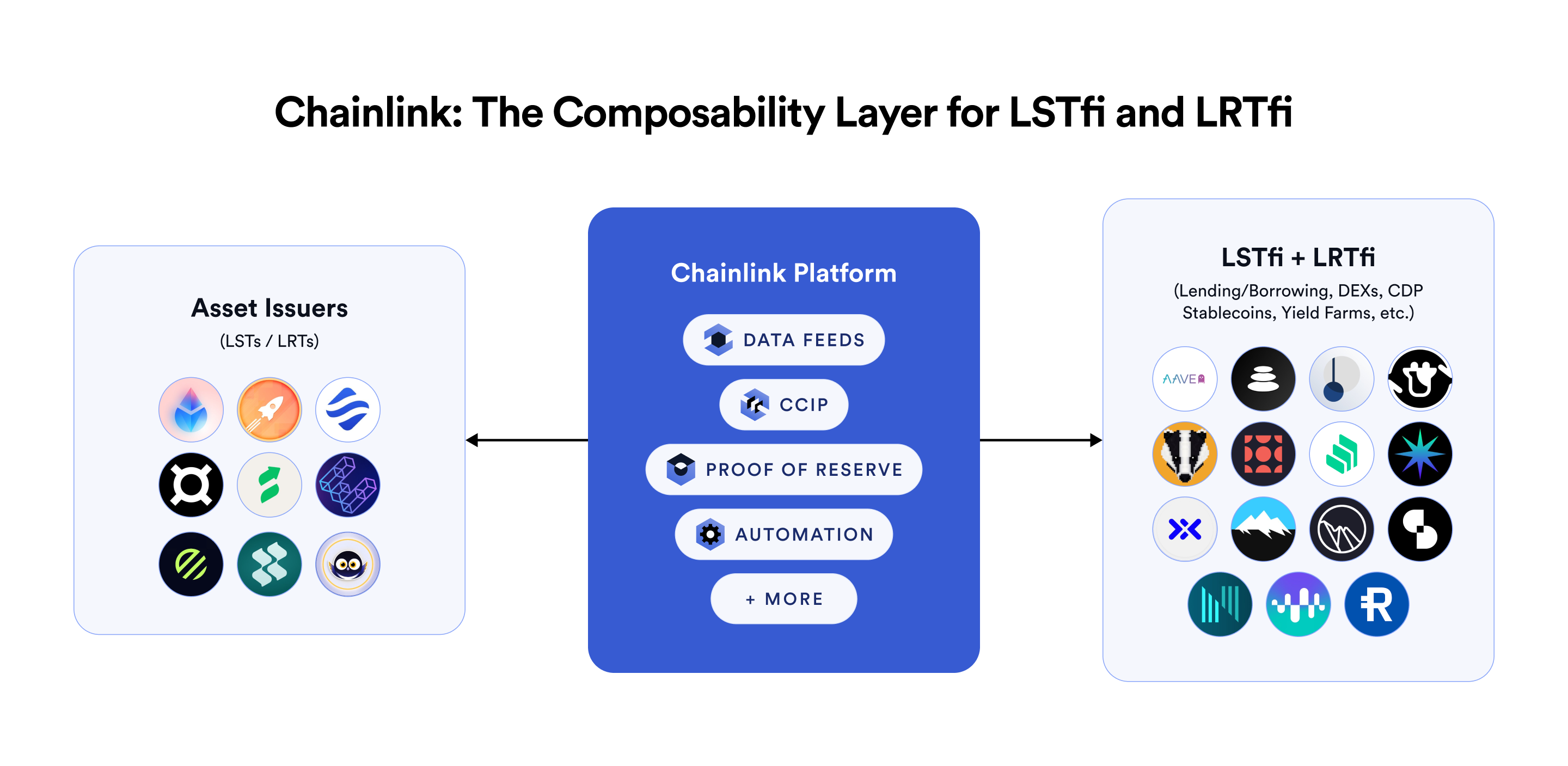
Chainlink Data Feeds
Pricing and market data play a critical role in the use of LSTs and LRTs in DeFi, such as providing trusted valuations when used as collateral or dynamically adjusting DEX swap logic to account for token rewards. It’s paramount for this data to be accurate and securely delivered onchain if the DeFi protocols supporting LSTs/LRTs are to remain secure and effectively mitigate against systemic risks.
Chainlink Data Feeds are the industry standard across DeFi, securing critical backend functions for high TVL protocols, such as Aave, even during times of extreme market volatility and heavy blockchain network congestion. There are two main categories of Chainlink Data Feeds when it comes to LSTs and LRTs in DeFi:
- Market Rate Feeds—Real-time price updates based on an asset’s volume-weighted aggregated market price. Market rate data is aggregated by multiple nodes from multiple data providers, who source pricing data from both centralized and decentralized exchanges, to accurately represent an asset’s market-wide price. Current Chainlink Market Rate Feeds for LST/LRTs include: Lido STETH, Rocket Pool RETH, Coinbase CBETH, Stader ETHx, Kelp restaked ETH (RSETH), Swell SWETH, Renzo ezETH, and Ether.FI weETH. Click here to search all the Chainlink Market Rate Feeds deployed across various blockchains and layer-2 networks.
- Exchange Rate Feeds—The internal redemption rates for an asset (i.e., the value/rate at which an asset can be redeemed or exchanged within that protocol’s ecosystem). This data is sourced directly from a specified contract on a source chain and relayed to a destination chain. Current Chainlink Exchange Rate Feeds for LSTs/LRTs include: Lido wstETH/ETH, Renzo ezETH/ETH, Coinbase cbETH-ETH, StaFi Staked ETH rETH-ETH, Frax frxETH-ETH (High / Low), Rocket Pool rETH-ETH, and Origin woETH/oETH.
Chainlink Market Rate or Exchange Rate Feeds can be utilized independently or in conjunction to unlock various DeFi use cases for LSTs/LRTs. A few ways they are already being used today include:
Pricing rewards-bearing tokens—The current price can be calculated by multiplying a rewards-bearing asset’s (i.e., LST/LRT) exchange rate by its underlying asset’s market rate. This methodology helps reduce certain pricing volatility risks associated with lower-liquidity rewards-bearing assets.

- Example 1: Aave prices assets using different methodologies depending on their type and liquidity profile. While many assets directly reference Chainlink Market Rate Feeds, LSTs on Aave are priced by multiplying the underlying asset’s market rate by the on-chain exchange rate of the corresponding LST. For example, the price of wstETH is calculated by multiplying the USD price of ETH by the exchange rate between wstETH and stETH (assuming a 1:1 peg between ETH and stETH).
- Example 2: BadgerDAO uses a combination of Chainlink Market and Exchange Rate Feeds to price stETH, the collateral backing its eBTC token (a crypto asset soft-pegged to the price of Bitcoin).
- Example 3: Dolomite upgraded to a combination of Chainlink Market and Exchange Rate feeds on Arbitrum to gain access to high-quality, tamper-proof price feeds which provide users with stronger assurances that collateral calculations for PT-eETH and PT-ezETH are supported by reliable, high-quality data.
Note: Users can choose to implement additional safeguards when pricing rewards-bearing assets. For example, Aave utilizes ratio caps to add additional upside protection.
Improving liquidity pool performance for rewards-bearing assets —For many LST/LRT liquidity pools in DeFi, LPs have the underlying token rewards continuously siphoned off to arbitrage traders due to suboptimal 1:1 swap pricing on AMMs. To avoid this, Chainlink Exchange Rate Feeds can be utilized to adjust swap parameters programmatically.
- Example: Balancer’s stableswaps (i.e., Composable Stable Pools) utilize Chainlink Exchange Rate Feeds made available on L2s to help ensure their AMM swap logic accounts for the current and correct exchange rate for rewards-bearing tokens on each trade. This means that as the value of the token rises due to reward accumulation, the pool continually accounts for the value increase to help ensure there isn’t constant loss by LPs due to arbitrage.

Chainlink CCIP
Given the reality of a multi-chain world, LSTs/LRTs need to be transferable cross-chain if they are to maximize their usage and liquidity. Furthermore, key data about LST/LRTs must move across chains to realize greater UX benefits.
Chainlink’s Cross-Chain Interoperability Protocol (CCIP) is a highly secure and flexible interoperability solution that enables developers to build customized cross-chain solutions for LSTs and LRTs. CCIP is the only blockchain interoperability protocol backed by level-5 security, which features multiple decentralized oracle networks and an independent Risk Management Network that verifies every cross-chain transaction.
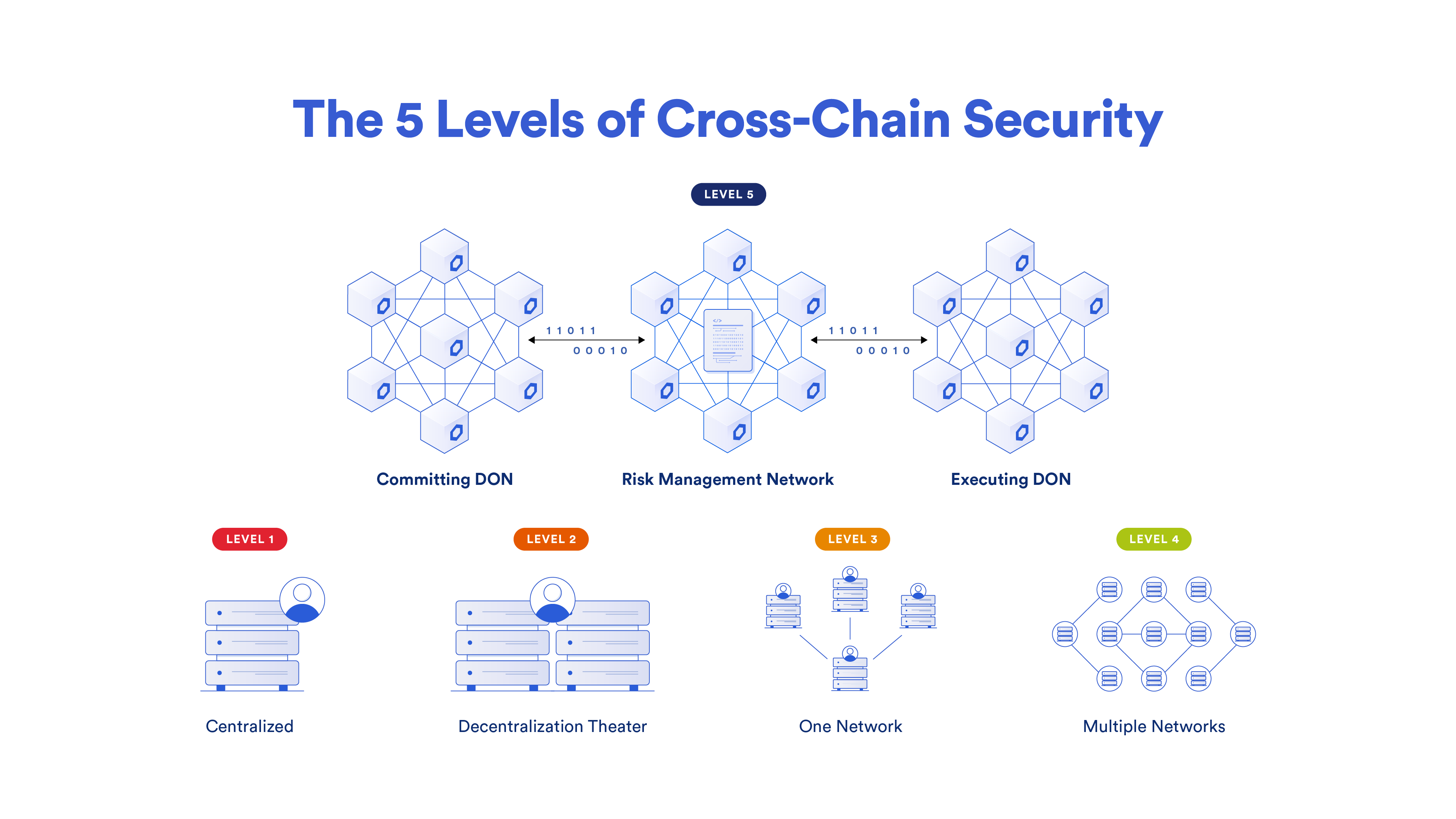
CCIP’s Simplified Token Transfers empower LST/LRT asset issuers to seamlessly turn their tokens into cross-chain native assets, which are secured by audited Token Pool Contracts that issuers maintain full control over and offer additional security features such as Rate Limits. CCIP-enabled tokens also become eligible to be listed on Transporter—a hyper-secure bridging app, powered by Chainlink CCIP.
CCIP also offers Programmable Token Transfers, where tokens and instructions on what to do with those tokens once they arrive on the destination blockchain are sent simultaneously as one cross-chain transaction (e.g., staking or swapping assets when they arrive at the destination chain).

The flexibility of CCIP enables protocols to choose between multiple different token-handling mechanisms for LST/LRTS:
- Burn and mint—Tokens are burned on a source chain, and an equivalent amount is minted on a destination chain. This enables the creation of cross-chain native tokens with a dynamic, unified supply across chains.
- Lock and mint—Tokens are locked on the chain they were natively issued on, and fully collateralized “wrapped” tokens are minted on destination chains. These wrapped tokens can be transferred across other non-native destination chains via burn and mint or be burned to unlock tokens back on the original issuing source chain.
- Lock and unlock—Tokens are locked on a source chain and an equivalent amount is released on a destination chain.
Some of the ways CCIP supports LST/LRTs include:
Enabling cross-chain transfers of LSTs and LRTs to increase accessibility within additional blockchain environments while maintaining the highest levels of cross-chain security. Notably, CCIP enables the creation of omnichain-native LST/LRT tokens through either “burn and mint” and/or “lock and mint” token transfer methods.
- Example 1: Origin Protocol is leveraging CCIP to facilitate cross-chain transfers of its enhanced-yield liquid staking token, OETH, across Ethereum and Arbitrum for a more seamless liquid staking user experience.
- Example 2: Stader integrated CCIP’s Simplified Token Transfers across Ethereum, Arbitrum, and Optimism to unlock cross-chain transfers of its liquid staking token ETHx.
Enabling cross-chain staking/restaking—End users can stake/restake assets directly on layer-2 chains to more easily access corresponding LST/LRT liquidity while also reducing associated complexity and gas costs via one of the following methods:
- Native L2 staking/restaking—This allows end users to deposit the underlying asset on an L2 and receive the LST/LRT directly on the L2, without having to interact with a more expensive L1 chain. Example: Renzo allows layer-2 users to deposit ETH/wETH directly into their L2 deposit contract, which mints ezETH tokens (based on the ezETH/ETH Exchange Rate delivered by Chainlink CCIP) and sends them back to the user for instant LRT liquidity. Renzo then batches deposited ETH/wETH and bridges it to Ethereum where it is restaked for ezETH, which is subsequently sent to the bridge contract to be burnt.
- Direct L2 staking/restaking—This allows users to easily access fully-backed LST/LRT liquidity on layer-2s by leveraging CCIP’s Programmable Tokens Transfers. Example: EigenPie is integrating Chainlink CCIP to enable its users to deposit ETH directly into their layer-2 contracts in order to receive the corresponding LRT (egETH) without ever having to leave the chain. Once users deposit ETH into the layer-2 contract, CCIP’s Programmable Token Transfers will bridge the tokens to Ethereum with instructions to restake them into Eigenlayer. CCIP is then used to lock the minted egETH on Ethereum and bridge it back to the L2 where it is minted and sent to the end user’s wallet address.
Chainlink Proof of Reserve
When DeFi protocols support LSTs/LRTs as collateral, they need to be certain that the reserves backing these assets are secure and fully collateralized. Performing checks on reserves is important for risk management, such as using the data to prevent the protocol from taking on bad debt from new loans or to trigger circuit breakers that protect the protocol against systemic risk.
Industry leaders use Chainlink Proof of Reserve (PoR) for its unmatched security, reliability, and compatibility in providing onchain transparency about the collateral reserves backing onchain assets such as LSTs/LRTs. Chainlink PoR is backed by the same time-tested decentralized oracle infrastructure that has secured Chainlink Data Feeds across blockchain mainnets for years. It’s why asset issuer Swell integrated Chainlink PoR on Ethereum as a way to provide onchain transparency around the staked ETH reserves backing their LST (swETH) and LRT (rswETH).
“We’re thrilled to integrate the industry-standard Chainlink Proof of Reserve to help monitor rswETH reserves in a reliable and timely manner. We’re also excited that Chainlink will support Swell L2 with Chainlink CCIP. By continuing our long-standing collaboration with Chainlink, we’re able to more effectively drive the growth of staking and restaking across DeFi.” — Daniel Dizon, Swell Founder
Chainlink Automation
Since LST/LRTs are supported by smart contracts, doing timely and secure upkeep on these smart contracts can be important to maintaining a safe and cost-efficient user experience. Chainlink Automation is an ultra-reliable and performant smart contract automation solution that can be utilized for triggering smart contracts that utilize cross-chain liquid staking tokens. For example, the multi-chain liquid staking protocol Stafi uses both Chainlink Automation and Chainlink CCIP to securely transport exchange rates across Arbitrum, Ethereum, and Polygon mainnets, effectively synchronizing asset rates cross-chain.
“We’re excited to be using Chainlink CCIP and Automation to help power asset rate synchronization on our liquid staking protocol across Ethereum, Arbitrum, and Polygon. Through the use of multiple Chainlink services, we were able to significantly advance the functionality of our protocol without compromising on security.” — Liam Young, the Co-Founder of StaFi

“The Chainlink Effect” for LSTs and LRTs
Chainlink is not only the industry’s most battle-tested oracle network; it is an expansive platform and ecosystem that fosters seamless interoperability among diverse financial applications.
By integrating with the Chainlink platform, LST/LRT asset issuers instantly gain composability across an array of DeFi protocols that also leverage Chainlink, such as lending/borrowing markets, stablecoins, DEXs, derivatives protocols, and more—ultimately driving shared high-security standards across protocols and increased opportunity for more user adoption and TVL.
This catalyzes a unique flywheel effect (i.e., The Chainlink Effect), where asset issuers gain instant composability within Chainlink’s growing ecosystem of leading DeFi protocols, which can help boost their asset’s utility, visibility, and adoption. As LSTs/LRTs become more adopted, Chainlink can further accelerate their growth by providing more advanced and additional services and security needed for the next level of scale.
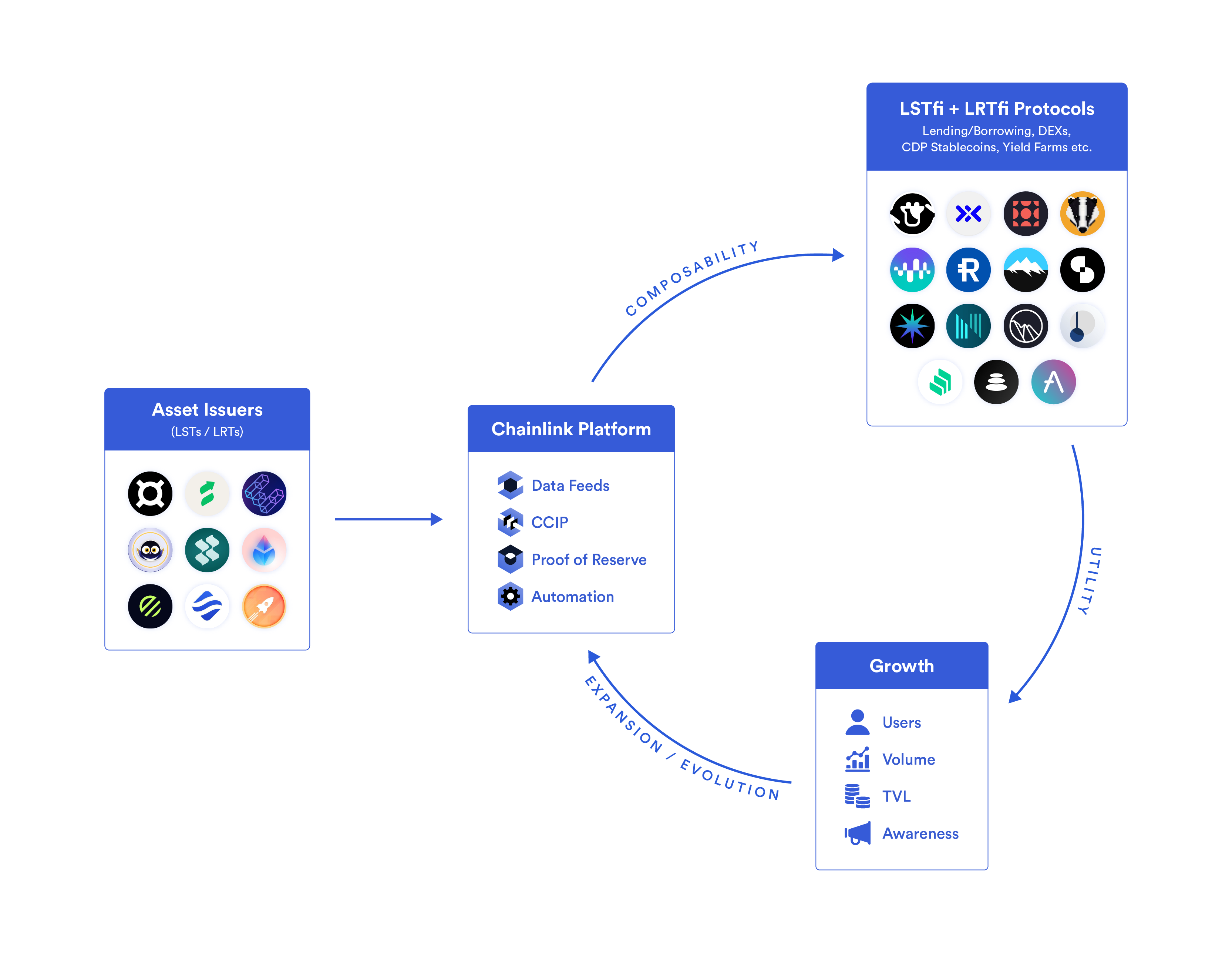
In short, Chainlink doesn’t just provide all of the services needed by LST/LRT assets issuers—it integrates them into a thriving network that positions them for exponential growth.
If you are an LST/LRT asset issuer or DeFi protocol looking to enhance your composability or accelerate your growth via The Chainlink Effect, reach out to us today. To learn more about Chainlink, visit chain.link, subscribe to the Chainlink newsletter, and follow Chainlink on Twitter, YouTube, and Reddit.
—
Disclaimer: This post is for informational purposes only and contains statements about the future, including anticipated product features, development, and timelines for the rollout of these features. These statements are only predictions and reflect current beliefs and expectations with respect to future events; they are based on assumptions and are subject to risk, uncertainties, and changes at any time. There can be no assurance that actual results will not differ materially from those expressed in these statements, although we believe them to be based on reasonable assumptions. All statements are valid only as of the date first posted. These statements may not reflect future developments due to user feedback or later events, and we may not update this post in response.
